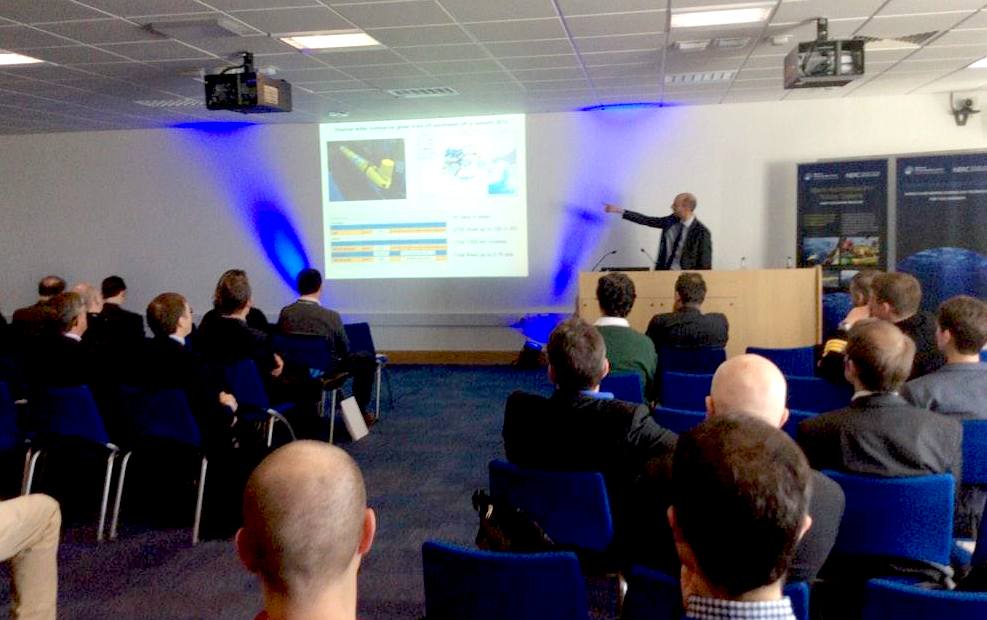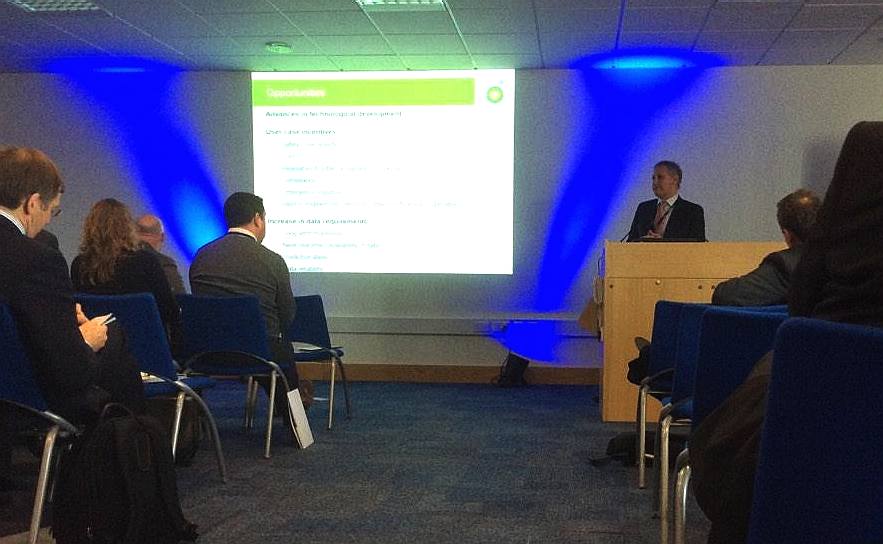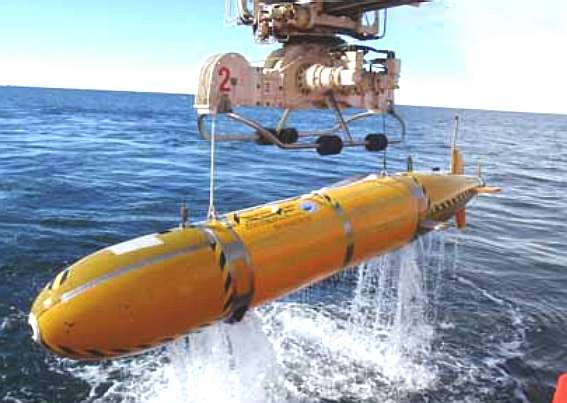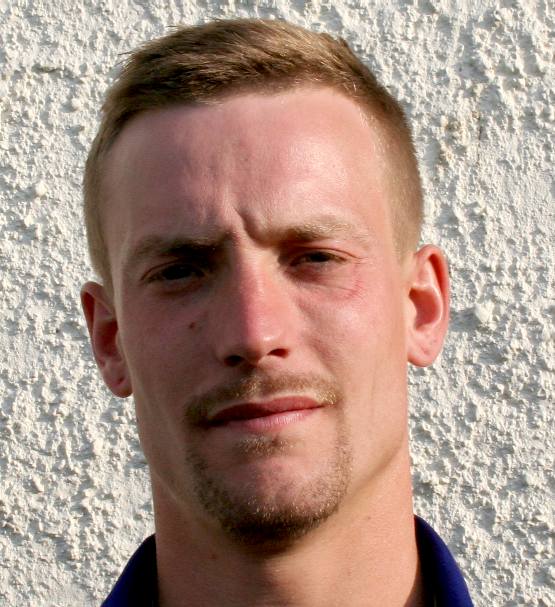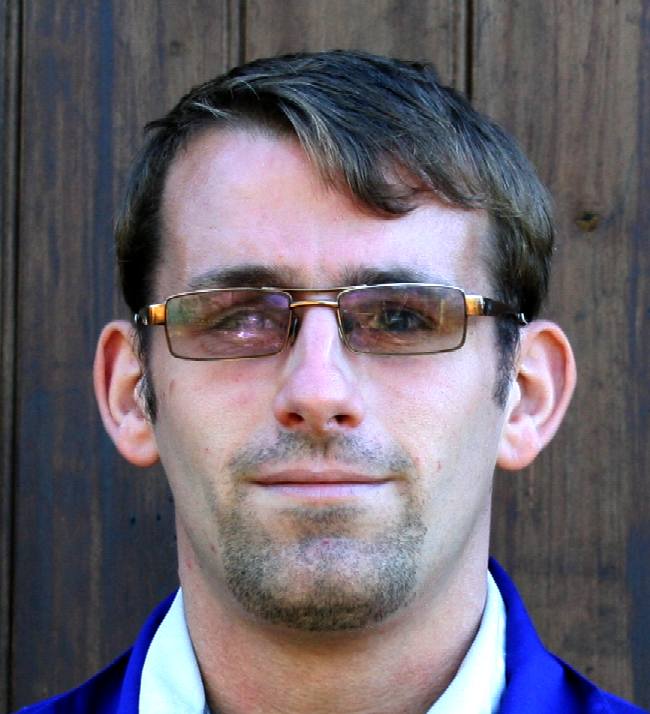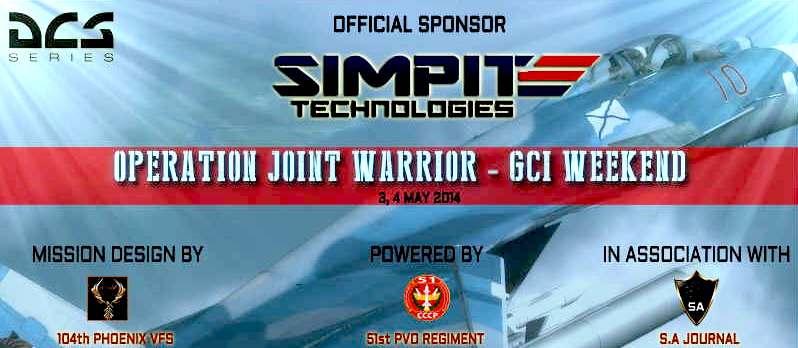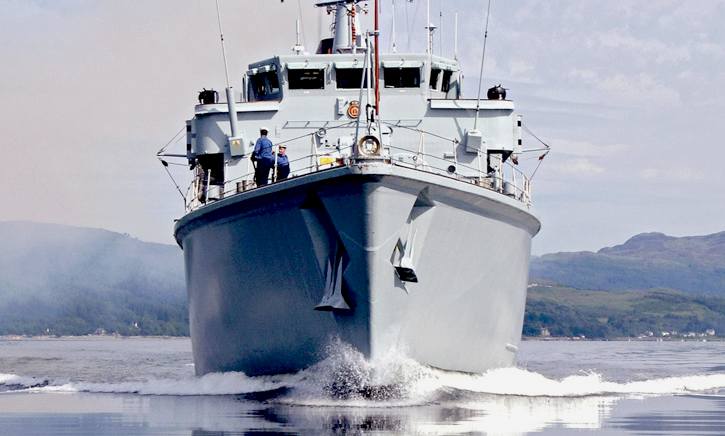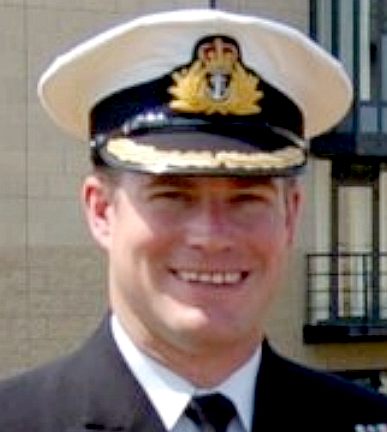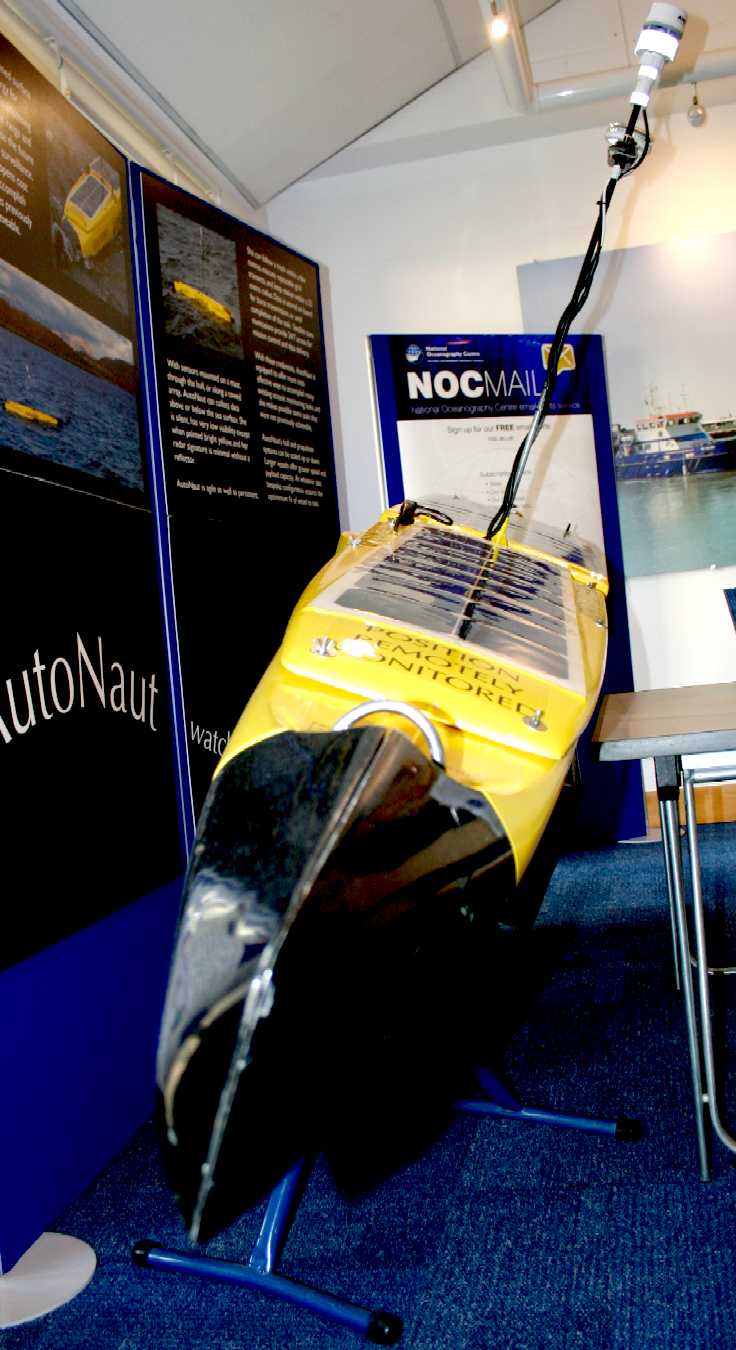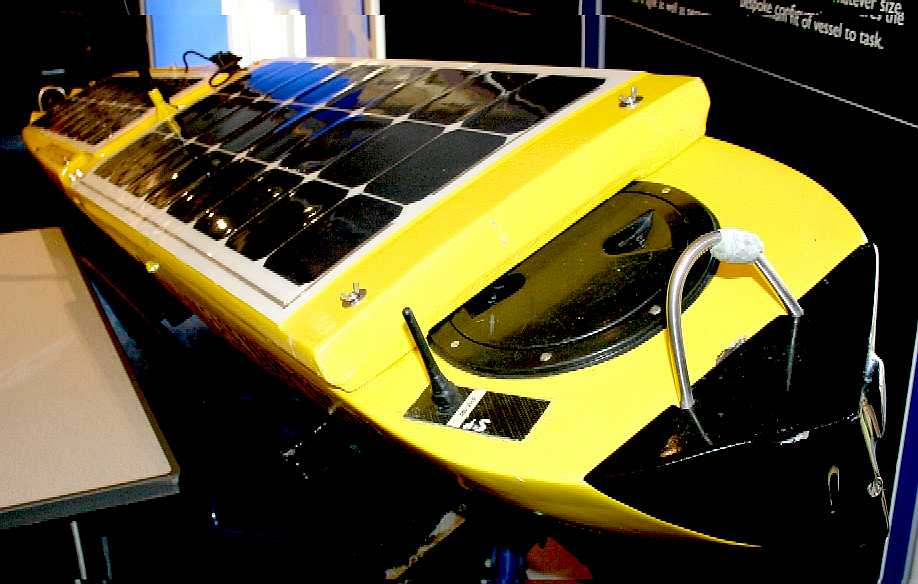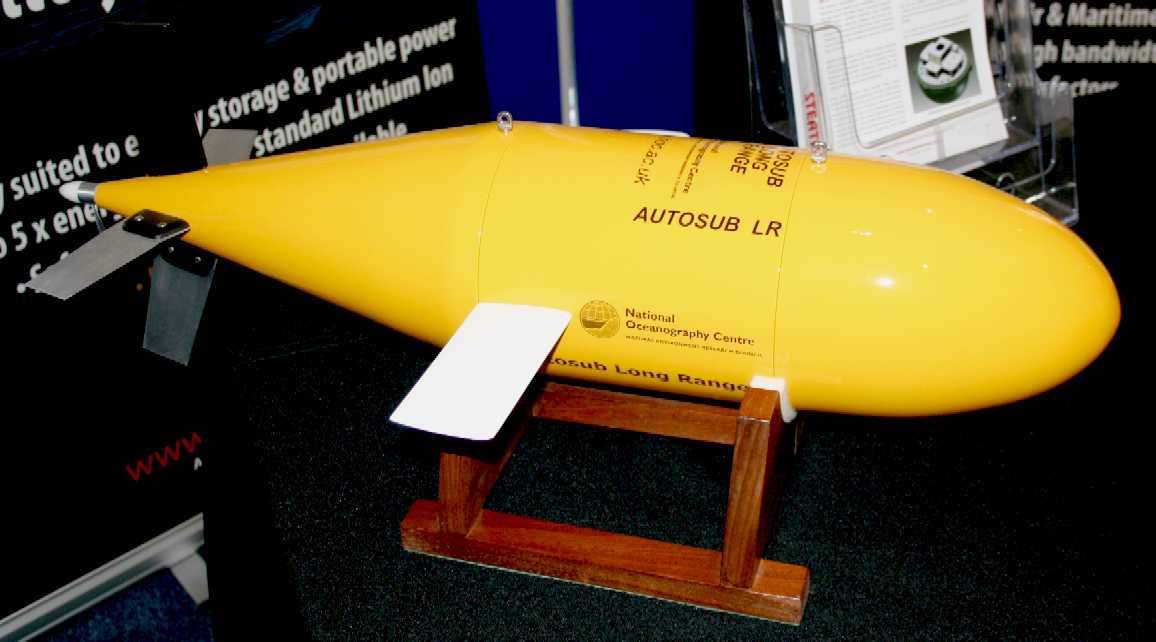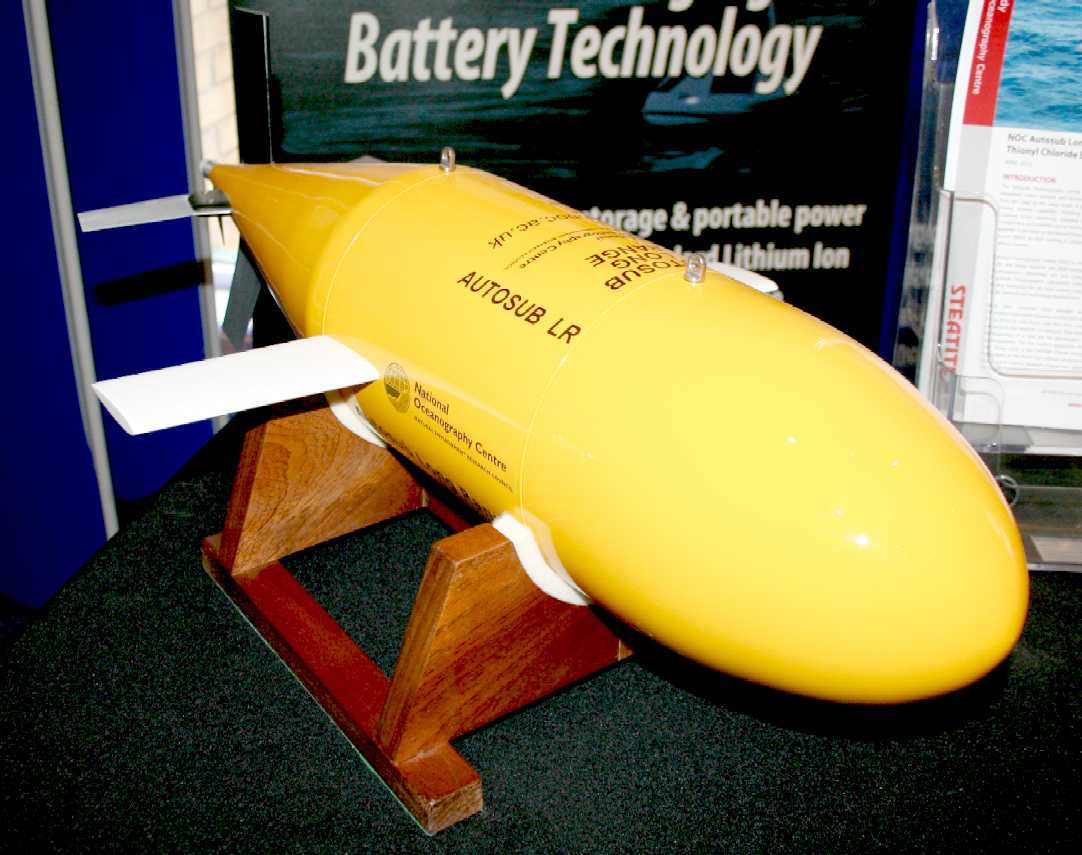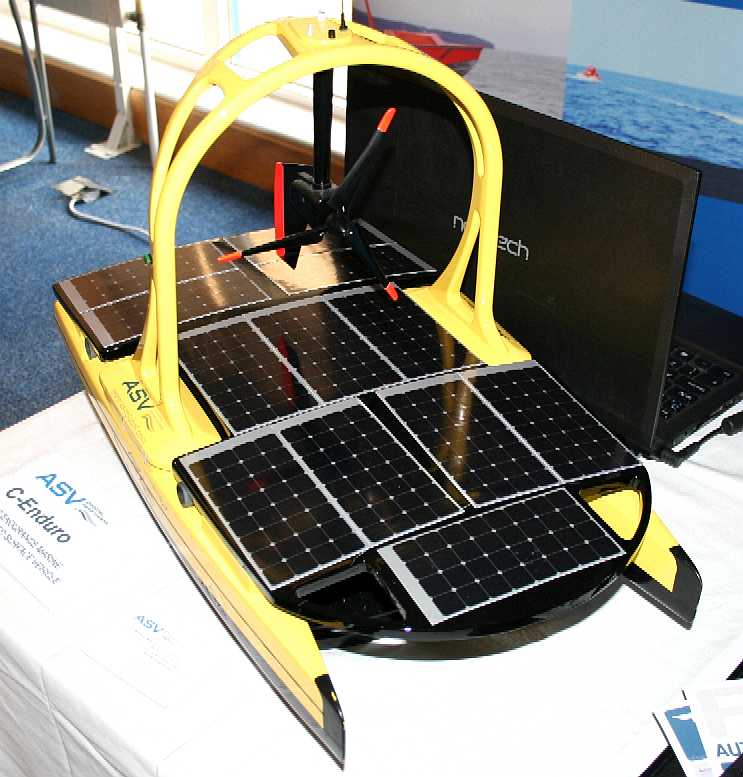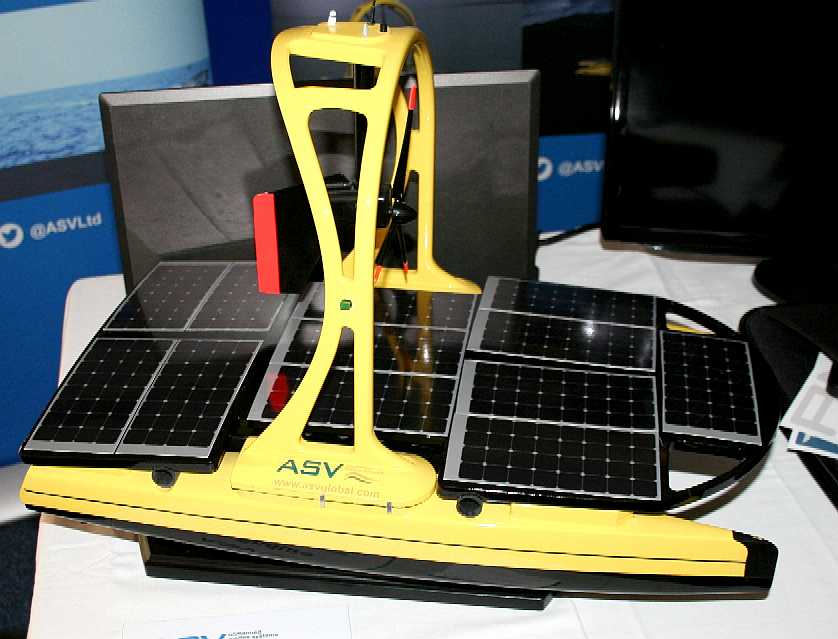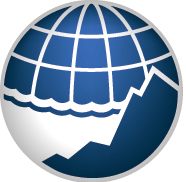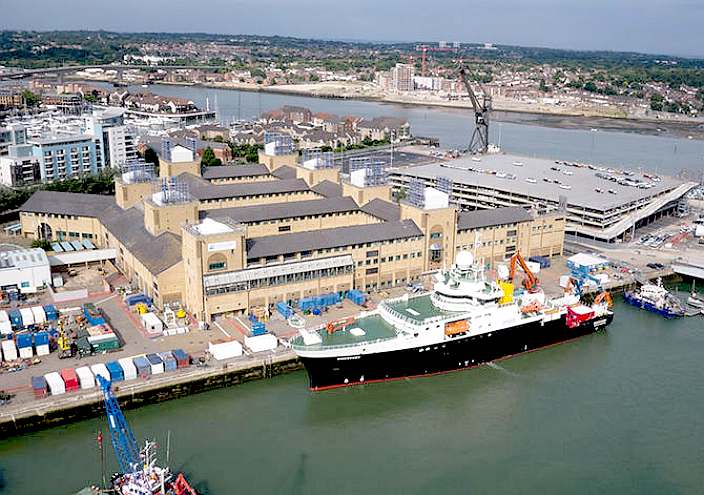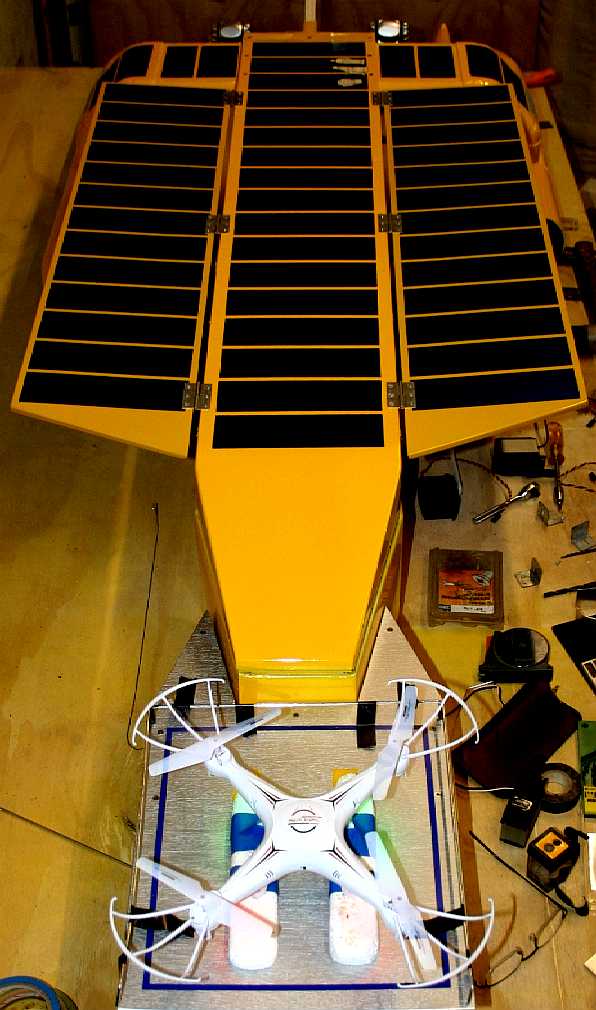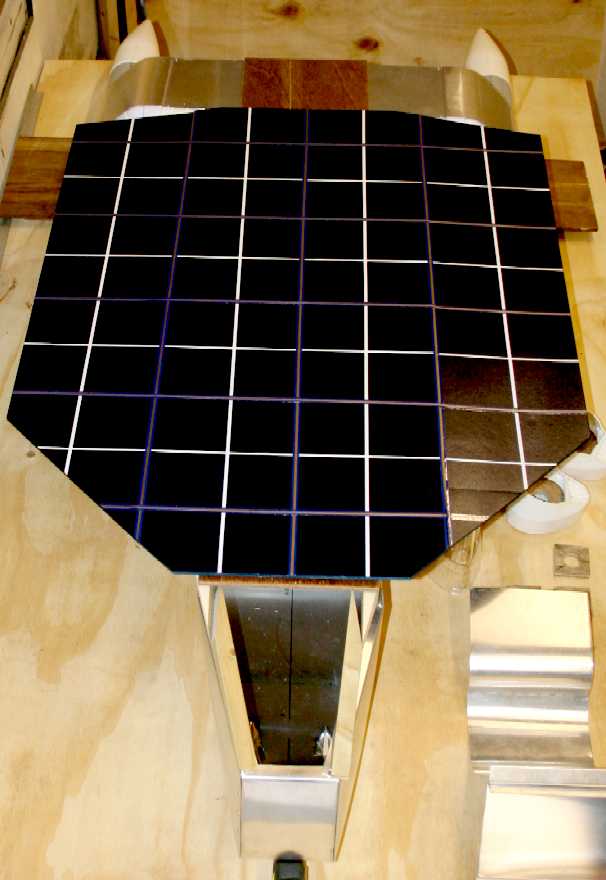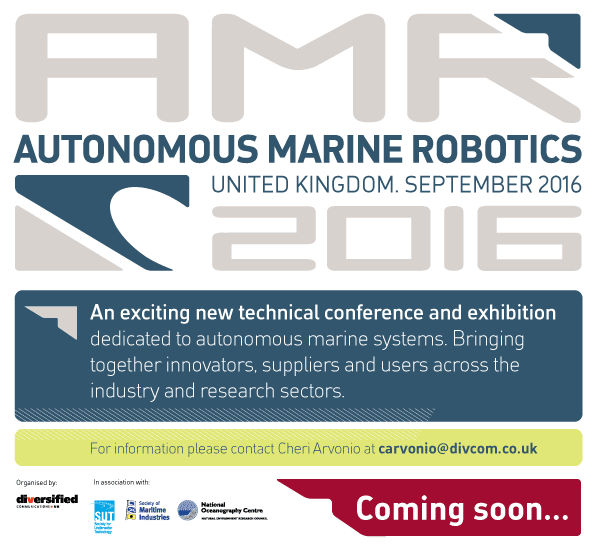|
MARS - Marine Autonomous Systems @ the National Oceanography Centre
|
|||
|
LEFT - The C-Enduro from ASV Global. We liked the look of the wind turbine, but noted from the launch and Youtube footage that the Ampair unit rarely seems to turn in anger. RIGHT - The AutoNaut from MOST is another of the interesting craft joined in a mission to track fish in the locality. This project received significant media coverage, with the BBC involved right from the outset.
MARINE AUTONOMOUS SYSTEMS (MARS) SHOWCASE AND WORKSHOPS NATIONAL OCEANOGRAPHY CENTRE, SOUTHAMPTON, 25th-26th FEBRUARY 2015
Recent capital investment, as part of the UK Government ‘Eight Great Technologies’ initiative, means that the
NERC MARS facility now comprises the largest and most diverse research fleet of marine autonomous systems in
Europe.
The NOC's Dr Russell Wynn gave a presentation outlining the work of the National Oceanography Centre's projects and capabilities, giving delegates an insight into operational limitations and the practical means to make the best of assets and data.
BRITISH PETROLEUM - BP's Peter Collinson addressed the audience on opportunities to use AUVs and ROVs to improve the efficiency of the oil and gas industry when it comes to surveying, monitoring and dealing with emergency situations. Better placed than most to appreciate global operational risks, potentially, BP might lead other energy companies in considering low cost monitoring methods such as resident AUVs that might be deployed in docking stations for extended periods - as one example given.
The MARS group is based at the National Oceanography Centre in Southampton, UK, under the auspices of the National Environmental Research Council (NERC). The MARS group exists to provide and to operate from their equipment pool of commercial underwater and surface vehicles for the British oceanographic science community and other qualifying organisations on short and long term basis and are operated by MARS and other trained NERC personnel.
Autosub recovery
SHOW CASE AND WORKSHOPS
Tues 24 February 2015
AM: Business Breakfast ‘working with NOC’
Open to all industry representatives
At this Breakfast Club meeting Kevin Forshaw gave a presentation on ‘Engaging with the NOC for Research & Development Support’. The National Oceanography Centre (NOC) is an invaluable source of support for your business. Whether it's engaging with them as a research partner, or accessing new knowledge for your company, their extensive expertise and facilities can help you access new market opportunities. The NOC is seeking to engage with business to apply its leading research thinking into positive socio-economic impact, and with supporting funds available from both UK and EC sources, there has never been a better time to explore how you could engage with them.
This session gave an overview of the various ways the NOC can engage with companies, large and small, local and international, with case studies featuring previous projects, and the outputs they have achieved.
Breakfast was served from 0830 with the presentation beginning at approximately 0915. The Breakfast Club was free to attend and meets twice yearly. Registration for this event closed on the 18th of February 2015.
SEAVAX - Project team members: Terry and Chris are both hands on, practical men who are disturbed by the mounting levels of plastic waste in our oceans. Terry was previously a teacher at an Eastbourne college and Chris is an engineer.
A representative from Bluebird Marine Systems Ltd attended on the 24th of February (am & pm) taking advantage of the networking breaks to speak with delegates about their organisations, services and equipment and mention about the proposed fleet of SeaVax ocean cleanup ships, that also have potential for scientific survey, monitoring and much more - as they harvest plastic waste. Should anyone who did not have a chance to speak with our delegate at the event and wish to contact the project team, please use the bluefish@ email address until we have a chance to set up a direct contacts and we will put you in touch with either Terry or Chris. BMS was at this event looking for sensing equipment to allow a marine robot to locate smaller particles to be able to adjust the filtering machinery for maximum recovery. The Lab on a Chip, Cytometer (CT-DO sensor) project might be just what the team are looking for to measure impedance to identify micro plastics in seawater.
KEVIN FORSHAW - started engaging in technology transfer for the maritime sector over 15 years ago when he established a Marine Thematic Group within the EC Innovation Relay Centre. He has since worked for 4 Universities, including Southampton, where he headed up Industry Engagement for the Southampton Marine and Maritime Institute. During this period, Kevin has established many industry / University collaborative research projects developing new technologies for maritime companies, that have leveraged £ millions of public funded support. Kevin is now Head of Enterprise at the UK National Oceanography Centre where he is heading up engagement with Marine Autonomous Systems related companies for the centre's Marine Autonomy and Robotic Systems Innovation Centre: MARSIC.
PM: MARS Industry Showcase
The event was open to all industry representatives
Following on from the business breakfast, this event will explore a range of potential Marine Autonomous Systems end-user needs from different industry sectors, whilst showcasing the capabilities of the MARS fleet and what has been achieved to date. A series of presentations will demonstrate the current and future applications of different platforms and sensors. There will also be focussed Q&A sessions exploring mechanisms for representatives from different industry sectors to partner in collaborative research projects to develop the Marine Autonomous Systems of tomorrow.
The indicative programme for the event will include presentations highlighting developments in autonomy for Carbon Capture and Storage, an overview of the Marine Autonomous Systems in Support or Maritime Operations (MASSMO) project. It will also include presentations from Oil & Gas, Offshore Renewables and the Defence sector, highlighting their potential applications for autonomy going forward. This was to have been followed by an opportunity to take a tour of the MARS Facility at the NOC with an introduction to the forthcoming Innovation Centre and how this will help stimulate developments in the sector, but for health and safety reasons, this was postponed.
JOINT WARRIOR - Is a NATO exercise held in Scotland in 2014 and a Situational Awareness virtual battlefield journal in association with the 51st PVO Regiment and the 104th Phoenix Virtual Fighter/Bomber Squadron. The PvP event is organized by Simpit Technologies, a leading company based in New Zealand specializing in extremely realistic projection solutions. The NATO version is the largest in Europe. Countries taking part in the maritime part of Joint Warrior are the UK, the United States, the Netherlands, France, Denmark, Norway, Spain, Germany, Lithuania, Belgium, Poland, Estonia and Latvia, with the US Navy’s Commander Destroyer Squadron 26 assuming overall command of the task group.
Joint Warrior is a UK tri-Service multinational exercise that involves numerous warships, aircraft, marines and troops. Commodore Jerry Kyd (Commander UK Task Group) is quoted as saying: "Alongside forces from the Army and RAF, it prepares maritime forces, including ships, submarines, aircraft and personnel very well for the challenges of real-world activity, from maritime security, counter-piracy to combat operations." Media enquiries should be go through the MOD's 24-hour press office number: 0207 218 7907
The Royal Navy were represented by Steve Prest RN (Robotics Officer), suggesting that autonomous vessels could play an increasingly important role in any modern Navy. The problem here being that one could die from the wait while the Admiralty sit on the fence waiting to be convinced. You'll need deep pockets and the patience of a Saint. Amusingly, the speaker gave the audience the famous example of Charles Parson's steam turbine ship, 'Turbinia', which upset Queen Victoria's Spithead Navy Review in 1897. This audacious publicity stunt worked such that in 1905 the first battleship to use a turbine, HMS Dreadnought, was launched. Sea also, John Ericsson's propeller, as an example of why not to become an innovator. Many a true word is spoken in jest.
ROYAL NAVY - Steve Prest is a Robotics Officer in the Royal Navy, with an important role to play in this rapidly developing technology, where not keeping up with developments by other navies, may mean that the UK is going backwards - especially where the UK is reliant on polluting nuclear powered submarines which, may one day be outlawed by International Treaty.
Joking aside, delegates were invited to suggest autonomous projects for a Navy competition - which unfortunately, we can find no details of - to be able to provide a link. We wonder how long it might be before the UK support competitions like the US Navy's Roboboat and Robosub events. The presentation carried with it some deeper insight, no doubt encouraging in national security terms where the function of the armed forces is to be ready should diplomacy fail. At the moment the UK is trailing, despite the fact that within the delegates assembled there was collectively sufficient know how to produce more advanced craft than the DARPA funded Leidos ASV project. Well done to the speaker who gave a well received talk.
The superb AutoNaut from MOST, was on display. The quality of build showed through when it encountered stormy conditions on its last mission - and not only survived, but managed to relay hundreds of pictures, where other ASVs ran into difficulties. Mind you, as any sailor will know, the elements can catch anyone off guard - even a robot.
Weds 25 February 2015
AM: MASSMO Partners Meeting
This half-day meeting will include presentations by partners in the recent MarineAutonomous Systems in Support of Marine Observations (MASSMO) project. The aim isto discuss initial results and share some of the lessons learned. Speakers from NOC,PML, Cefas and UK Met Office confirmed.
PM: Workshop on MAS operational and legal issues
The event was open to all.
This half-day workshop will explore the legal and operational issues associated with autonomous systems deployments in the marine environment. It will be of interest to anyone involved in marine autonomous systems deployments (now and in the future), including NERC scientists, industry representatives, and end users from the policy and operations side.
NOC's Autosub LR is a long range AUV that is powered by Steatite Lithium Thionyl Chloride batteries. This energy solution makes it possible for the NOC to collect significant additional data at depths of 6,000 metres.
Thurs 26 February 2015
MARS Showcase for NERC community / other public sector stakeholders
Open to all NERC scientists and invited end users
This one-day meeting will showcase the capabilities of the NERC MARS fleet to the NERC scientific community and other key public sector stakeholders, e.g. Defra, Royal Navy, UK Met Office. The objective is to ensure that potential users are fully aware of the range of platforms and sensors now available, and for MARS personnel to receive feedback from the user community about future development needs. Guidance will also be provided about how to include MARS equipment in future funding proposals.
Confirmed speakers include Karen Heywood (University of East Anglia; submarine gliders), Doug Gillespie (University of St Andrews; cetacean acoustics using autonomous vehicles), Mark Inall (SAMS; North Atlantic Glider Base and open ocean gliders), John Howe (SAMS; coastal and shelf AUV mapping), Phil Anderson (SAMS, Remotely Piloted Aircraft), Veerle Huvenne/Henry Ruhl (NOC; deep-water AUV/ROV mapping) and Dr Russell Wynn (NOC, MASSMO).
A nice model of ASV's C-Enduro was on display at the MARS event. The full size C-Enduro features an under-slung Ampair wind generator suspended from a swivel from a looped frame that also carries communications. Solar panels are used, laid simply as a suspended deck above a catamaran twin hull-form.
Fri 27 February 2015
AM: Workshop on AUV seabed and habitat mapping for marine policymakers
Open to all public sector marine policy staff by invitation
This half-day workshop is targeted at policymakers involved in seabed and habitat mapping, e.g. for Marine Protected Area and MSFD survey and monitoring. It is anticipated that staff from Defra, JNCC, Cefas, Natural England, Marine Scotland and SNH will attend. The objectives are to demonstrate detailed Defra-funded case studies where AUVs have recently delivered high-quality seabed mapping data, and explore mechanisms for uptake of this technology in future policy-driven work.
MARINE ACADEMIC INSTITUTIONS A-Z
Australian Maritime - Geneve - Hawaii Renewable - NERC - Newcastle Naval
NOC Oceanographic - Plymouth - Portsmouth - Seoul Naval - SOTON
Strathclyde
Marine - Sussex
- TU
Delft - USP South
Pacific - Webb
Institute
THE NOC building at Southampton suffers from a lack of parking for visitors, meaning a trudge from a wind swept dockside location some hundreds of yards distant and at least £15 payable for 7 hours, adding to exhibitor setup time complications. Not so much of a problem in good weather, but in the rain, visitors would arrive soaked. The dockside facilities and hospitality are though excellent.
LINKS & REFERENCE
http://auvac.org/community-information/community-news/view/935 Oceanology International OI China 2014 Conference Programme Remote Technology Underwater Kevin Forshaw NOC robot vehicles launched from Plymouth-on fish tracking mission http://noc.ac.uk/conference/mars http://www.metoffice.gov.uk/ http://www.royalnavy.mod.uk/ https://twitter.com/nocnews http://noc.ac.uk/news/robot-vehicles-launched-from-plymouth-morning-fish-tracking-mission http://noc.ac.uk/research-at-sea/nmfss/mars http://www.msubs.com/ http://www.xylemanalytics.co.uk/index.php http://www.amc.edu.au/ http://www.gavia.is/ http://www.strath.ac.uk/na-me/
PATENT PENDING - The big boy in oceanic gyre cleanups and research, Bluefish ZCC technology provides a means to act on information received during oceanographic surveys. Small autonomous marine survey craft are fine as far as collecting data is concerned, but less effective in certain circumstances where useful work is required. An adapted ZCC as per the above 'proof of concept' vessel would be capable of harvesting plastic from the 5 major ocean gyre garbage pools, that so far nobody seems to want to tackle. The concept is codenamed SeaVax. SeaVax ships are not designed for outright speed, they are designed to carry out specific heavy-duty tasks - as a robotic workhorse. See the picture below of the Enterprise 1 feasibility boat under construction, sporting a standard Bluefish 300m2 solar array. The picture above shows the SeaVax with 200m2 of solar panels.
BIOLOGICAL SAMPLING - A Bluefish ZCC can be manned or unmanned as a scientific work station. Depending on specification, this incredibly versatile design can be put to most uses, even collecting and transporting live samples, with a modified ROV dock - used as a capture and holding tank for marine life. Such dock might instead house a dedicated AUV submersible.
A Bluefish ZCC ship uses no diesel fuel in the quest to monitor the oceans 24/7 and 365 days a year. What makes all of this possible is the revolutionary energy harvesting system that provides a power to weight ratio of more than 3kW per ton, with up to 7kW per ton being attainable using more exotic materials. That gives oceanographers the power to do more.
OIL SPILLS - Dedicated versions of the SeaVax platform could be deployed as oil clean-up robots, to help cope with disasters like the Deepwater Horizon.
PLASTIC OCEANS - Adapted ZCCs operating in SeaNet fashion, could form a fleet to clean up the oceans of harmful waste that is estimated to be some 269,000 tons in size across an area roughly twice the size of Texas.
ARCTIC - ATLANTIC - BALTIC - BERING - CARIBBEAN - CORAL - EAST CHINA - ENGLISH CH - GOM GULF MEXICO - INDIAN - MEDITERRANEAN - NORTH SEA - PACIFIC - PERSIAN GULF - SEA JAPAN - STH CHINA PLANKTON
- PLASTIC
ENGLAND - PLASTIC
OCEANS - SEA
LEVEL RISE - UNEP
|
|||
|
This website is Copyright © 2015 Bluebird Marine Systems Ltd. The names Bluebird™, Bluefish™, SeaNet™, SeaVax™ and the blue bird and fish in flight logos are trademarks. The color blue is an essential element of the marks. All other trademarks are hereby acknowledged.
|
